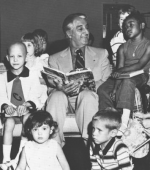OT- Charities
- Thread starter Mstan85
- Start date
You are using an out of date browser. It may not display this or other websites correctly.
You should upgrade or use an alternative browser.
You should upgrade or use an alternative browser.
Me!I'm looking on naming a few charities as beneficiaries for my will.
Not Penn State football related, any good recommendations? So far the only one we have agreed upon is
Covenant House PA.
Thanks,
I am an attorney who has drafted a lot of Wills over 50 years in practice. Two charities that I have had clients speak highly of are, nationally, St. Jude Children's Research Hospital in Memphis, TN. and locally, in the Pittsburgh area, Animal Friends. I have heard good things about your choice of Covenant House, as well. As I always tell my clients, do your own due diligence before donating.I'm looking on naming a few charities as beneficiaries for my will.
Not Penn State football related, any good recommendations? So far the only one we have agreed upon is
Covenant House PA.
Thanks,
I am a fan of the Boys and Girls Clubs. I admire your willingness to help others.
moms lost her GMA my 88 yo real mom beat it twice. Served a delicious lunch today, lovely to see her n dad
I would do an immense amount of research to verify they actually spend the majority of your donation on actual charitable work and not on paying themselves to work for the non-profit.
I’d stay as close to home as I could. My church, my school , local sport teams little leagues etc
St. Jude is a wonderful organization that I’ve been supporting for years. I highly recommend it. To see those little kids and their families as they arrive is heartbreaking. To see so many leave healthy is heart warming and amazing.
We have supported St Jude’s among several other charities. What are you looking to support? I am not lobbying for this specific charity but suggest looking for similar in your area. One of the members in the Den is the president of Maryland Therapeutic Riding. They provide programs for all sorts of folks in need of mental health help, hope, self assurance, self actualization, confidence, recovery, etc.
They serve everyone from disabled Vets and Vets with PTSD to children with every form of challenge, including emotional, mental, physical and more.
Beyond that, no kill shelters need assistance more than ever. Every charity does. What do you love that you feel is underserved? Kids? Dogs? Veterans? Food and nutrition initiatives? Trout? Horses?
All the best with your decision and thank you For mentioning your endeavor. While it is personal, it is a great reminder.
They serve everyone from disabled Vets and Vets with PTSD to children with every form of challenge, including emotional, mental, physical and more.
Beyond that, no kill shelters need assistance more than ever. Every charity does. What do you love that you feel is underserved? Kids? Dogs? Veterans? Food and nutrition initiatives? Trout? Horses?
All the best with your decision and thank you For mentioning your endeavor. While it is personal, it is a great reminder.
I would do an immense amount of research to verify they actually spend the majority of your donation on actual charitable work and not on paying themselves to work for the non-profit.
My number one rule of thumb is to avoid charities founded and run by celebrities, athletes, retired presidents, etc.
St Jude's and Victory Junction.....
Victory Junction is about eight miles from my house - they do good work.
Charity Navigator has been a good resource for vetting charities. CN looks at orgs' financial statements, to see how many dollars really go towards stated mission.

As a young man, Danny Thomas had a simple goal: to entertain people and be successful enough at it to provide for his wife and family. But work wasn’t easy to come by.
As he and his family struggled, his despair grew. He wondered if he should give up on his dreams of acting or find a steady job. He turned to St. Jude Thaddeus, the patron saint of hopeless causes. “Show me my way in life,” he vowed to the saint one night in a Detroit church, “and I will build you a shrine.”
That prayer to St. Jude marked a pivotal moment in his life. Soon after, he began finding work, eventually becoming one of the biggest stars of radio, film and television in his day.
And as one of the world’s biggest celebrities, Danny used his fame to fulfill his vow to St. Jude Thaddeus and to change the lives of thousands of children and families.
A unique research institution
Danny’s shrine to St. Jude Thaddeus was originally to be a general children’s hospital located some where in the south. Danny’s mentor, Cardinal Samuel Stritch, recommended he look to Memphis, Tennessee, the cardinal’s hometown.
By 1955 Danny and a group of Memphis businessmen he’d rallied to build the hospital decided it should be more than a general children’s hospital. At the time, the survival rate for childhood cancers was 20%, and for those with acute lymphoblastic leukemia (ALL) — the most common form of childhood cancer — only 4% of children would live.
Funding the hospital
Danny began raising money for his vision in the early 1950s. By 1955, the Memphis business leaders who’d joined his cause also began local fundraising efforts. Danny also wanted to get the word out across the country about what he was doing and enlist the support of everyone he could.
No child should die in the dawn of life
St. Jude Children’s Research Hospital opened its doors on February 4, 1962, based on Danny's dream that "no child should die in the dawn of life." Since then, we’ve made incredible strides in childhood cancer research. We’ve helped improve the survival rate of childhood cancer from 20% to 80%. And ALL, the disease with a virtual death sentence in 1962, now has a survival rate of 94 percent.
St. Jude Children's hospital or anything cancer related. 26.2 with Donna is a marathon where all proceeds go directly to breast cancer research which my mom died of when I was 14.I'm looking on naming a few charities as beneficiaries for my will.
Not Penn State football related, any good recommendations? So far the only one we have agreed upon is
Covenant House PA.
Thanks,
Kyle started Victory Junction after Adam was killed....doing many bike rides. The story I have heard is that Tony Stewart piedged 1 million dollars and that helped kickst a rt the program....is that true?Victory Junction is about eight miles from my house - they do good work.
I can't validate the Tony Stewart contribution story, CP58, but VJ Gang got great support from the racing community when it kicked off. Even the beds in the rooms are NASCAR-themed, down to real brake calipers being used at the four corners of each bed.Kyle started Victory Junction after Adam was killed....doing many bike rides. The story I have heard is that Tony Stewart piedged 1 million dollars and that helped kickst a rt the program....is that true?
Kevin Bacon time: My wife's best friend went to HS with Kyle.
Richard and Lynda (before she passed) were very active in the local community. Randleman has recently put up a statue of Richard and Lynda near the town municipal building.
